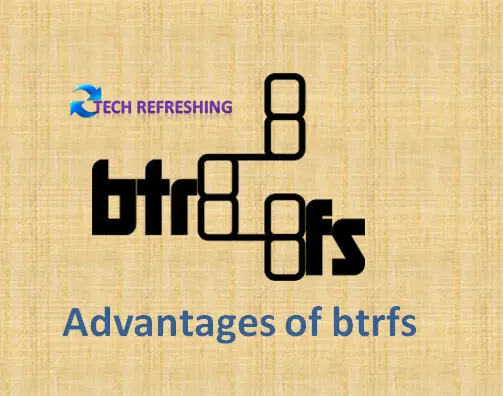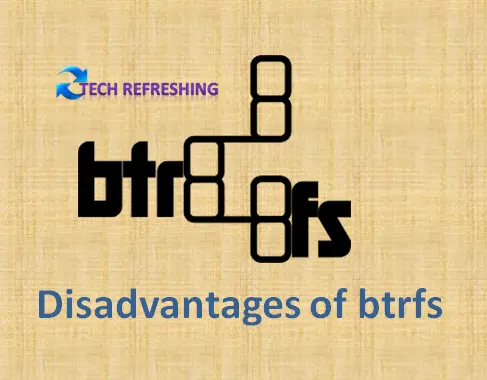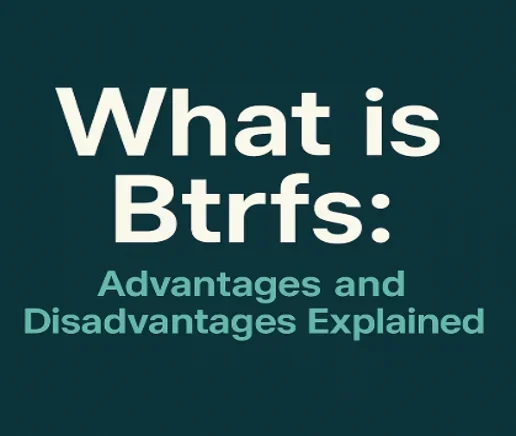In the world of Linux filesystems, Btrfs (B-tree file system) has emerged as a powerful and modern alternative to traditional filesystems like ext4. Pronounced as “Butter FS” or “B-tree FS,” Btrfs is designed to address the limitations of older filesystems while introducing advanced features suited for today’s storage demands. Whether you’re a system administrator, a developer, or a Linux enthusiast, understanding Btrfs can help you make informed decisions about managing your data. In this comprehensive guide, we’ll explore what Btrfs is, its key features, advantages, disadvantages, and how it compares to other filesystems.
What is Btrfs?
Btrfs is a modern, copy-on-write (CoW) filesystem developed for Linux. Initially started by Chris Mason at Oracle in 2007, Btrfs aims to provide scalability, reliability, and advanced features for managing large storage systems. Unlike traditional filesystems that were designed for smaller, simpler storage setups, Btrfs is built to handle the complexities of modern hardware, including large-scale storage arrays, solid-state drives (SSDs), and cloud environments.
The “B-tree” in Btrfs refers to the data structure used to organize and manage files, which allows for efficient storage, retrieval, and management of data. Btrfs is often compared to ZFS, another advanced filesystem, but it’s native to Linux and tightly integrated with the Linux kernel, making it a popular choice for Linux distributions like Fedora, Ubuntu, and SUSE.
Btrfs is not just a filesystem; it’s a storage management solution that combines features like snapshots, RAID, compression, and subvolumes into a single package. These capabilities make it ideal for enterprise environments, home servers, and even personal desktops where data integrity and flexibility are paramount.
Key Features of Btrfs

Before diving into the advantages and disadvantages, let’s take a closer look at the core features that make Btrfs stand out:
- Copy-on-Write (CoW): Btrfs uses a CoW approach, meaning that when data is modified, a new copy is created instead of overwriting the original. This ensures data integrity and enables features like snapshots.
- Snapshots: Btrfs supports lightweight, read-only, or writable snapshots, allowing users to capture the state of a filesystem at a specific point in time. Snapshots are useful for backups, system recovery, and testing.
- Subvolumes: Btrfs allows the creation of subvolumes, which are independent filesystem hierarchies within a single Btrfs filesystem. This is useful for organizing data or managing snapshots.
- Built-in RAID Support: Btrfs supports multiple RAID levels (RAID 0, 1, 5, 6, and 10) natively, eliminating the need for separate RAID tools like mdadm.
- Data Compression: Btrfs can compress data on-the-fly using algorithms like ZLIB, LZO, or ZSTD, reducing storage requirements and potentially improving performance on SSDs.
- Checksums and Data Integrity: Btrfs uses checksums to detect and repair data corruption, ensuring high levels of data integrity.
- Scalability: Btrfs is designed to handle large storage pools, supporting filesystems and files up to 16 exabytes in size.
- Online Maintenance: Btrfs supports online filesystem checks and defragmentation, allowing maintenance without unmounting the filesystem.
- Deduplication: Btrfs supports data deduplication, which identifies and eliminates redundant data to save space.
- Integration with Linux Tools: Btrfs integrates seamlessly with Linux utilities like btrfs-progs for management and monitoring.
Now that we understand what Btrfs is and its core features, let’s explore its advantages and disadvantages in detail.
Advantages of Btrfs

Btrfs offers a range of benefits that make it an attractive choice for modern storage needs. Here are the key advantages:
1. Enhanced Data Integrity
Btrfs’s use of checksums ensures that data corruption is detected and, in some cases, automatically repaired. This is particularly important for large storage systems where silent data corruption can go unnoticed. The CoW mechanism further enhances data integrity by ensuring that original data is preserved until new data is safely written.
2. Snapshots for Easy Backups and Recovery
Snapshots are one of Btrfs’s standout features. They allow users to create point-in-time copies of the filesystem, which can be used for backups, system rollbacks, or testing. For example, before applying a system update, you can take a snapshot, and if something goes wrong, you can easily revert to the previous state. Snapshots are lightweight and don’t consume much space unless significant changes are made.
3. Flexible Storage Management with Subvolumes
Subvolumes provide a flexible way to organize data within a single Btrfs filesystem. For instance, you can create separate subvolumes for /home, /var, and / without needing separate partitions. This makes it easier to manage snapshots or apply different policies (e.g., compression) to specific subvolumes.
4. Built-in RAID Support
Btrfs’s native RAID support simplifies storage management by eliminating the need for external RAID tools. It supports various RAID levels, allowing users to configure redundancy or performance based on their needs. Unlike traditional RAID setups, Btrfs RAID can handle drives of different sizes, making it more flexible.
5. Efficient Use of Storage with Compression and Deduplication
Btrfs’s compression feature reduces storage requirements by compressing data on-the-fly. This is particularly beneficial for text-heavy workloads, virtual machine images, or databases. Deduplication further optimizes storage by eliminating redundant data, which is useful in environments with multiple copies of similar files.
6. Scalability for Large Storage Systems
Btrfs is designed to scale to massive storage pools, supporting filesystems up to 16 exabytes. This makes it suitable for enterprise environments, cloud storage, and data centers where storage demands are constantly growing.
7. Online Maintenance and Management
Btrfs allows for online filesystem checks, defragmentation, and resizing, reducing downtime. For example, you can shrink or expand a Btrfs filesystem without unmounting it, which is a significant advantage for always-on systems.
8. Integration with Modern Linux Distributions
Btrfs is well-supported in modern Linux distributions like Fedora (which uses Btrfs as the default filesystem) and Ubuntu. This ensures that users have access to up-to-date tools and documentation, making it easier to adopt and manage Btrfs.
9. Support for SSD Optimization
Btrfs includes features like TRIM support, which optimizes performance and longevity for SSDs. Its CoW and compression capabilities also align well with the characteristics of solid-state storage.
10. Community and Development Support
Btrfs is actively developed and maintained by a community of contributors, with contributions from companies like Oracle, Red Hat, and SUSE. This ensures that Btrfs remains relevant and receives regular updates and bug fixes.
Disadvantages of Btrfs

While Btrfs offers many advantages, it’s not without its drawbacks. Here are the key disadvantages to consider:
1. Complexity and Learning Curve
Btrfs’s advanced features come with a steep learning curve. Configuring and managing snapshots, subvolumes, RAID, and compression requires a good understanding of Btrfs’s tools and concepts. For beginners or small-scale setups, simpler filesystems like ext4 may be more practical.
2. Performance Overhead
The CoW mechanism and checksums, while great for data integrity, can introduce performance overhead, especially for write-heavy workloads. For example, databases or virtual machines that perform frequent small writes may experience slower performance on Btrfs compared to ext4.
3. RAID Limitations
While Btrfs supports RAID, its RAID 5 and RAID 6 implementations are considered less mature and have had stability issues in the past. The “write hole” problem, where data could become corrupted during a power failure, has been a concern, although recent kernel updates have improved reliability. For critical systems, users may prefer dedicated RAID solutions or ZFS.
4. Stability Concerns
Although Btrfs has been in development for over a decade, it’s still considered less mature than ext4. Some users have reported stability issues, particularly with complex setups or older kernel versions. While Btrfs is stable for many use cases, it’s not yet as battle-tested as ext4 in all scenarios.
5. Resource Usage
Btrfs’s advanced features, such as compression, deduplication, and snapshots, can consume significant CPU and memory resources. This may not be ideal for low-powered devices like older servers or embedded systems.
6. Limited Adoption in Some Environments
While Btrfs is gaining traction, it’s not as widely adopted as ext4 or XFS in certain enterprise environments. This can lead to compatibility issues or a lack of expertise when troubleshooting complex setups.
7. Repair and Recovery Challenges
If a Btrfs filesystem becomes corrupted, repairing it can be more complex than with simpler filesystems. Tools like btrfs check and btrfs rescue are available, but they require expertise, and recovery is not always guaranteed.
8. Lack of Full Deduplication Support
While Btrfs supports deduplication, it’s not as robust as ZFS’s implementation. In-band deduplication (real-time) is resource-intensive, and out-of-band deduplication requires additional configuration, which may deter some users.
Btrfs vs. Other Filesystems
To put Btrfs in context, let’s briefly compare it to other popular Linux filesystems:
- Btrfs vs. ext4: Ext4 is simpler, faster for certain workloads, and more mature, but it lacks advanced features like snapshots, compression, and built-in RAID. Btrfs is better for complex storage needs, while ext4 is ideal for basic setups.
- Btrfs vs. ZFS: ZFS offers similar features to Btrfs, including snapshots, RAID, and compression. However, ZFS is not native to the Linux kernel and requires more resources. Btrfs is lighter and better integrated with Linux, but ZFS is considered more mature for enterprise use.
- Btrfs vs. XFS: XFS is designed for high-performance, large-scale storage but lacks features like snapshots and CoW. Btrfs is more feature-rich but may not match XFS’s raw performance for specific workloads.
When Should You Use Btrfs?
Btrfs is an excellent choice for:
- Home Servers and NAS: Snapshots, RAID, and compression make Btrfs ideal for network-attached storage (NAS) or home servers.
- Enterprise Storage: Its scalability and data integrity features suit large-scale storage systems.
- Development and Testing: Snapshots allow developers to experiment and revert changes easily.
- SSD-Based Systems: TRIM support and compression optimize SSD performance and storage.
However, you might avoid Btrfs for:
- Low-Power Devices: Its resource usage may be too high for older hardware.
- Performance-Critical Applications: Workloads with heavy writes may perform better on ext4 or XFS.
- Simple Setups: If you don’t need advanced features, ext4 is simpler and more reliable.
Conclusion
Btrfs is a powerful, modern filesystem that brings a wealth of advanced features to the Linux ecosystem. Its snapshots, CoW, compression, and RAID support make it a compelling choice for complex storage needs, from home servers to enterprise data centers. However, its complexity, performance overhead, and occasional stability concerns mean it’s not a one-size-fits-all solution.
When deciding whether to use Btrfs, weigh its advantages against its drawbacks and consider your specific use case. For users who need flexibility, scalability, and data integrity, Btrfs is a fantastic option. For simpler or performance-critical setups, alternatives like ext4 or XFS may be more appropriate.
As Btrfs continues to mature, its adoption is likely to grow, especially with support from major Linux distributions. Whether you’re a seasoned sysadmin or a curious hobbyist, experimenting with Btrfs can open up new possibilities for managing your data effectively.
Frequently Asked Questions (FAQ) About Btrfs: Your Guide to Understanding This Linux Filesystem
What is Btrfs, and what does it stand for?
Btrfs, pronounced “Butter FS” or “B-tree FS,” is a modern copy-on-write (CoW) filesystem for Linux. The “B-tree” refers to the data structure it uses to organize files efficiently. Developed to handle large-scale storage and advanced features, Btrfs is designed for everything from personal desktops to enterprise servers. It’s packed with tools like snapshots, compression, and built-in RAID, making it a flexible choice for managing data.
How does Btrfs differ from ext4?
Ext4 is a traditional Linux filesystem known for its simplicity, speed, and reliability. Btrfs, on the other hand, is more advanced, offering features like:
Snapshots: Capture the filesystem’s state for backups or recovery.
Compression: Save storage space with on-the-fly compression.
Built-in RAID: Manage redundancy without external tools.
Subvolumes: Organize data flexibly within a single filesystem.
While ext4 is great for basic setups, Btrfs shines in complex environments needing scalability and data integrity.
What are the main advantages of using Btrfs?
Btrfs offers several benefits, including:
Data Integrity: Checksums detect and fix corruption.
Snapshots: Easy backups and system rollbacks.
Compression and Deduplication: Save storage space.
Scalability: Supports filesystems up to 16 exabytes.
Built-in RAID: Flexible redundancy options.
Online Maintenance: Resize or defragment without downtime.
These features make Btrfs ideal for home servers, NAS, and enterprise storage.
What are the disadvantages of Btrfs?
While powerful, Btrfs has some drawbacks:
Complexity: Steep learning curve for managing features like snapshots or RAID.
Performance Overhead: CoW and checksums can slow write-heavy workloads.
RAID Limitations: RAID 5/6 implementations are less mature.
Resource Usage: Compression and deduplication can tax CPU and memory.
Stability: Less battle-tested than ext4 for some edge cases.
For simple or low-power systems, ext4 might be a better fit.
Can I use Btrfs on an SSD?
Absolutely! Btrfs is well-suited for SSDs thanks to features like:
TRIM Support: Optimizes SSD performance and lifespan.
Compression: Reduces write amplification and saves space.
CoW: Aligns with SSDs’ wear-leveling needs.
Just ensure your kernel supports TRIM, and consider tuning compression settings for optimal performance.
Also Read
Best Terminal Tools Every Linux User Should Know in 2025


